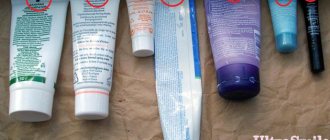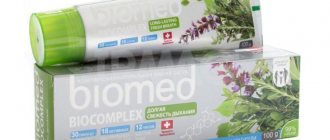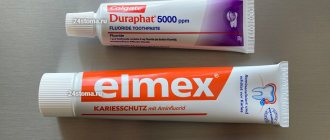An electric toothbrush is many times more effective than a manual one - it is easier to clean your teeth and it makes more movements per minute than we can imagine.
We constantly write about the fact that for safe use, you should not choose hard brushes and do not press the brush hard on your teeth. In this text we will tell you how to choose the right toothpaste that is suitable for use with an electric toothbrush.
What is the abrasiveness of toothpaste?
Dental cleaning products contain abrasives that provide the following functions:
- lightening the shade of enamel;
- reducing the density of stones;
- strengthening the surface of the teeth.
Each product contains a different amount of abrasives. In order not to harm the teeth, they should be no more than 100 units. Cleansers soften the stones, but not enough to completely remove them. Therefore, it is recommended to periodically visit your dentist for professional cleaning.
Abrasives are recommended for polishing the surface of teeth. Enzymes that settle on the surface of the teeth during chewing of food are eliminated. Therefore, no damage to the enamel occurs.
Calcium
Products with calcium, including for personal hygiene, are usually recommended for children. Some dentists believe that the content of this element does not in any way affect the effectiveness of the paste, because a decent amount of calcium is contained in human saliva, and it is almost not absorbed during brushing.
However, it is generally accepted that a safe children's toothpaste should always contain calcium. Because this element is very important for the growing child’s body and in any case will not be superfluous.
Advantages and disadvantages of abrasive toothpastes
The presence of abrasives in toothpaste produces the following positive effects for humans:
- instant results;
- lightening of enamel up to 2 tones, which helps lighten teeth when smoking or privately drinking caffeine;
- safety for humans when applied correctly and after reading the instructions for use;
- affordable prices, lower than professional whitening;
- less harm compared to professional whitening.
Abrasive particles cause the following harm:
- thinning of the surface of the teeth;
- risk of microcracks in enamel;
- no effect when purchasing products with a low content of abrasive particles.
Not recommended!
If a person has a lot of fillings in their mouth, a product with abrasive particles is not recommended because the color of adjacent teeth will be different. The product cannot make the filling lighter.
Paste composition
How do abrasive pastes whiten enamel? They contain polishing and whitening particles, degrading agents and enzymes that prevent plaque deposits. The combination of these components quickly removes dental plaque mechanically and polishes the enamel surface.
Previously, the abrasive components of toothpastes were based on chalk and calcium compounds. Later, the use of ordinary chalk was abandoned, since it does not combine with the healing elements of the bleaching mass. Instead, chalk with a low concentration of iron and aluminum oxides is used in preparations.
One of the main components of bleaching products is silicon compound. These compounds combine well with any additives. The addition of fluoride is also a frequently used ingredient: fluoride compounds are especially useful in areas with low levels of this microelement in drinking water. However, if in your region the content of fluoride elements exceeds the norm, it is better to avoid such pastes.
Despite the ability of fluoride to effectively clean plaque from enamel, it can be harmful to teeth. Before purchasing a whitening paste, carefully study its composition. Instead of fluorine, it may contain its compounds:
- sodium monofluorophosphate;
- sodium fluoride;
- aminofluorides.
The abrasive properties of toothpaste can speed up the wear of enamel if you use the preparations unwisely.
Active substances
Thanks to these substances, you can achieve a visual effect of whiteness. These include:
- abrasives and polishing agents;
- enzymes that dissolve bacterial plaque;
- hydrogen peroxide and its compounds;
- complexing agents responsible for removing tartar and plaque.
Abrasive components include:
- silicon compounds;
- calcium carbonate;
- titanium dioxide;
- polyethylene;
- clay, soda;
- charcoal.
Silicon compounds (Silica, Hydrated Silica, aluminosilicates) help dissolve bacterial plaque and gently clean the surface of the tooth crown. These compounds do not cause allergic reactions and are tolerant to other components of the cleansing mass of the drug.
Calcium carbonate provides high abrasiveness to dental preparations, but has an aggressive effect on the enamel. The drug with this component should not be used by persons with weak enamel structure.
Titanium dioxide has a high abrasiveness and whitening effect. This component is included in almost all white toothpastes. Titanium dioxide is also used in artistic paints (white).
Polyethylene is sometimes included in whitening pastes, but this component can cause periodontal disease. Synthetic particles of the substance accumulate in periodontal pockets and attract bacteria. Many leading companies have refused to include polyethylene compounds in their products.
Clay is a natural substance with high abrasive properties. This component can be found in Thai toothpastes.
Enzymes in pastes
Enzymes are substances of natural origin. These include:
- papain;
- bromelain.
Papain is obtained from Carica papaya (melon tree). This substance promotes the breakdown of protein structures, its action is similar to gastric juice. With the help of papain, plaque actively dissolves and can be easily removed when brushing the teeth.
Bromelain is an extract from pineapple. In its effect on dental plaque, bromelain is similar to papain - it dissolves the protein structures of dental plaque.
Lightening components
These include aggressive acids in small doses:
- hydrogen peroxide;
- Urea peroxide.
In small proportions, these substances are weak in whitening and do not destroy the enamel structure. The whitening effect is achieved due to the abrasive components of toothpastes containing peroxide. However, for some reason, consumers believe in the whitening effect of peroxide more than in the action of enzymes and abrasives.
Removing Tartar
What components of toothpastes help soften and remove tartar? These include:
- potassium pyrophosphate;
- sodium pyrophosphate;
- sodium tripolyphosphate;
- sodium hexametaphosphate.
These compounds fight plaque well, but remove calcium salts from the enamel structure. This contributes to its thinning and demineralization.
What abrasive pastes best whiten enamel? They contain larger abrasive particles. They quickly eliminate visible pigmentation and polish the surface. However, you should not get carried away with whitening pastes: they quickly thin out the enamel layer. This threatens the development of hyperesthesia, that is, increased sensitivity of teeth to the thermal and acidic characteristics of food/drinks. Hyperesthesia brings a lot of discomfort while eating and brushing your teeth.
RDA index of toothpastes: table
Abrasiveness is determined depending on the rda index. They are listed in the table.
This is interesting: Does toothpaste help with acne?
| Index rda | Description |
| Up to 50 units | Daily care to prevent enamel thinning |
| Up to 80 units | Gentle cleansing, suitable for all ages, long-term use because there is no therapeutic effect |
| 80-100 units | It is used for medicinal purposes, so it is applied in courses with breaks between them. |
| 100 units or more | Aggressive influence at the sites of application, stones are eliminated, the enamel is lightened, but there is a high risk of destruction of its surface with frequent application |
Attention! To prevent negative effects on teeth, the product is applied only as prescribed by the dentist.
Conclusion
The choice of abrasive pastes is quite large; they should be carefully selected, focusing on the composition and condition of the oral cavity. For sensitive teeth, abrasive toothpastes with an RDA of up to 70 are suitable. If the teeth are healthy, then from 70 to 100. It is better to use them in courses, no more than two weeks, and not use electric toothbrushes during this time. Pastes above 100 RDA can damage teeth; it is better to use them no more than 1-2 times a week.
The best option would be to ask your dentist for advice. In some countries, the doctor prescribes toothpaste as well as medicine. And no one would think of buying pasta based on advertising or idle advice.
List of abrasive toothpastes
List of products without abrasive components and of high quality.
- Lacalut White. The composition includes silicon dioxide, sodium, potassium hydroxide. The product removes plaque and stone, not aggressively, but gently. Rda coefficient 100 units.
- President White Plus. Contains silicon dioxide, calcium glycerophosphate, fluorine. Rda 200 units. The effect appears during the day, the enamel brightens.
- Silca artic white. Rda 80 units. Abrasives are applied to the teeth, softening and removing plaque. They do not destroy tissue. With prolonged application, the enamel becomes lighter.
- Rembrandt anti-tobacco. Rda 110 units. Gently cleanses, removes plaque, brightens teeth when smoking and drinking coffee.
- Rocs pro freshmint. Rda 139 units. Protection against caries, relieving inflammation, eliminating dark spots on enamel.
- Splat whitening. Rda 90 units. High fluoride content, which strengthens teeth and prevents plaque accumulation and the formation of stones.
Not recommended!
Before purchasing, the condition of the teeth is taken into account. If they are susceptible to damage, the listed products are not recommended.
Using whitening pastes
Since after bleaching the enamel becomes most sensitive to dyes, manufacturers do not recommend drinking coffee, smoking or eating chocolate for several hours after using the pastes.
If there is a lot of hard plaque and tartar on your teeth, it is advisable to first remove these formations in the dental office. Toothpastes will not be able to cope with a large amount of work: they have a preventive effect, not a curative one.
If you have fillings on your front teeth, they will become more visible due to whitening. Keep this in mind. Your smile will become unattractive due to the contrasting color of your enamel and fillings. Perhaps pastes containing hydrogen peroxide will solve the problem.
Pros and cons of non-abrasive toothpastes
Before purchasing a product, it is recommended to look at the composition. If it contains no abrasives, it has the following positive aspects:
- no excessive impact on the enamel, preservation of integrity, prevention of microcracks;
- soft effect when removing plaque;
- content of microelements and vitamins that saturate the surface of the teeth;
- contains antibacterial agents that prevent the proliferation of microbes;
- Possibility of daily use without harm to health.
This is interesting: Is it possible to carry toothpaste in hand luggage?
Non-abrasive pastes have disadvantages:
- no whitening effect;
- there is no way to remove stains on enamel after cigarettes and coffee;
- lack of therapeutic effect for thinning enamel, inflammation of the gums.
Additional Information!
If the paste contains grain, plaque is cleaned without the use of abrasive components.
Pay attention to the Sonic Friendly mark
Some pastes may be marked Sonic Friendly as a hint. This means the paste is suitable for use in conjunction with an electric toothbrush. The icon does not determine the quality of the paste, but only gives a hint.
CURAPROX Enzycal 950 toothpaste
Toothpaste CURAPROX PerioPlus SUPPORT chx 0.09%
Megasonex toothpaste
Toothpaste ROCS PRO Electro&Whitening
Non-abrasive toothpaste: list
Dentists recommend a list of non-abrasive toothpastes that improve the quality of teeth.
- Safety suitable for children and adults. The composition includes plant extracts that eliminate inflammation.
- Parodontax. Apply daily, which improves hygiene indicators. Contains microelements that improve the quality of the tooth surface. Antiseptic substances destroy bacteria.
- Prevention and treatment of gum inflammation. It is used from the age of 12. The contained microelements heal wounds and microcracks in the gums.
- Splat Professional Ultracomplex. The composition includes plant components with a regenerating, antiseptic, anti-inflammatory effect. The risk of hypersensitivity to the components of the product and damage to dental tissue is reduced.
- Biorepair intensive night. Natural components restore enamel, eliminating the negative effects of bacteria overnight. In the morning there is no unpleasant smell or accumulation of plaque.
When choosing a toothpaste for daily application, read the indicated composition. It may contain abrasive ingredients that are not suitable for all users. They are used for a whitening effect and strengthening enamel.
What components should not be there - recommendations for selection
A good oral care product should not only be effective, but also safe. Some manufacturers saturate their products with components, a high concentration of which can cause serious harm to human health in general. When choosing, pay attention to the composition - it is advisable that it does not contain the following components:
- propylene glycol - used as a solvent, including in the production of antifreeze and brake fluid. It has the properties of accumulating in the liver and kidneys, and also contributes to the gradual destruction of cellular proteins,
- Triclosan is a fairly powerful antibiotic that effectively fights pathogenic microflora, but can negatively affect the condition of the kidneys, lungs and digestive organs. The presence of this component requires prior consultation with a specialist,
- parabens are preservatives that can significantly extend the shelf life of the product. However, these substances accumulate in the endocrine glands and can provoke the development of malignant neoplasms. Allowed only in minimal concentrations,
- polyphosphates - used to soften water and stabilize reactions, therefore they are often present in washing powders. When they freely penetrate the body, they increase cholesterol levels and contribute to the development of inflammatory processes.
And these are not all dangerous substances, but they are the ones most often added to increase efficiency and improve cleaning properties. If you have some problems with your teeth or gums, it is best to consult your dentist first. Only a specialist can correctly assess the condition of the enamel and mucous membranes, and then offer the best option for your specific case.
Watch the video “How to choose a toothpaste”
- Kuryakina N.V., Savelyeva N.A. Preventive dentistry, 2003.
How to know if you have tartar
Look in the mirror, paying attention to the condition of your teeth from the inside. The fact that at first glance the enamel seems clean and quite light is not yet an indicator. Calculus is a cloudy white, yellowish or almost black deposit between the teeth or at the bottom of the gums.
It would be good if these unpleasant formations caused only aesthetic displeasure. Their presence threatens the formation of gum pockets, where the remnants of eaten food will accumulate, exposing the base and, as a result, diseases of soft and hard tissues.









